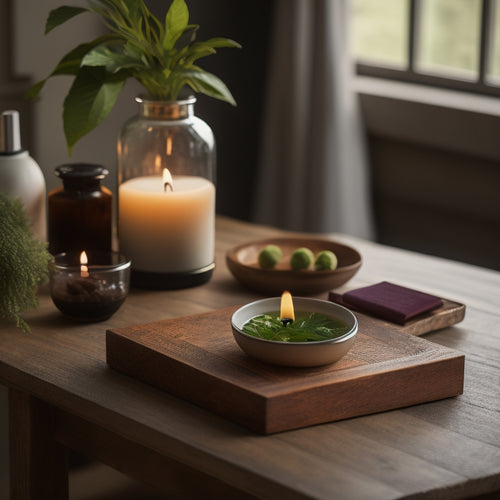
How Do I Protect My Hanging Clothes?
Share
You can protect your hanging clothes from damage, pests, and wrinkles by taking a few simple steps, from choosing the right hanger to maintaining a dry and dark storage space. Start by selecting hangers that suit your garments, like wooden or metal ones for heavy items. Keep your closet ventilated and consider using dehumidifiers to prevent moisture damage. Store your clothes away from direct sunlight to avoid fading, and use natural deterrents to repel pests. Finally, organize your clothes to minimize wrinkles and consider steam pressing to relax fibers. By following these tips, you'll be well on your way to keeping your hanging clothes looking their best – and there's more to learn about keeping them protected.
Key Takeaways
• Choose the right hanger material (wood, metal, or plastic) to ensure sturdy support and prevent damage to your garments.
• Control humidity levels using ventilation, dehumidifiers, or desiccant packets to prevent moisture damage to your clothes.
• Protect your clothes from direct sunlight by hanging them in filtered sunlight or using UV-blocking window film to prevent fading and discoloration.
• Use natural deterrents like cedar blocks or moth balls to repel pests and rodents, and store clothes in airtight containers or bags to prevent infestations.
• Organize and store hanging clothes neatly, allowing them to breathe while hanging, to minimize wrinkles and creases.
Choosing the Right Hangers
When it comes to protecting your hanging clothes, selecting the right hanger is essential, as it can make a significant difference in maintaining their quality and extending their lifespan.
You have various hanger materials to choose from, such as wood, metal, or plastic. Each material has its advantages and disadvantages. For instance, wooden hangers are sturdy and eco-friendly, while metal hangers are durable and can hold heavy garments. Plastic hangers, on the other hand, are lightweight and affordable.
Additionally, you have different hanger types to contemplate, like velvet, slimline, or padded hangers. Velvet hangers are great for delicate fabrics, while slimline hangers are perfect for saving space.
Protecting From Moisture Damage
Moisture damage can silently sabotage your wardrobe, so it's crucial to take proactive measures to shield your hanging clothes from humidity's corrosive effects.
To prevent moisture buildup, consider using humidity control methods like ventilation systems or dehumidifiers. You can also utilize Desiccant packets, which absorb excess moisture in the air, keeping your clothes dry and protected. Place these packets near your hanging clothes or in the closet to maintain a dry environment.
By controlling humidity levels, you'll greatly reduce the risk of moisture damage, ensuring your clothes remain fresh and intact.
Take control of humidity today and give your wardrobe the protection it deserves!
Storing Out of Direct Sunlight
By maintaining your hanging clothes away from direct sunlight, you'll prevent the fading, discoloration, and weakening of fabrics that can occur when UV rays bombard your garments.
Direct sunlight can cause irreparable damage to your clothes, especially those made of delicate or sensitive materials.
To guarantee UV protection and prevent fabric fading, consider the following:
- Hang clothes in a closet or area that receives filtered or indirect sunlight.
- Use window treatments like curtains or blinds to block direct sunlight.
- Consider using UV-blocking window film or applying a UV-protective coating to your windows.
Keeping Pests and Rodents Away
You can safeguard your hanging clothes from unwanted critters by taking proactive steps to repel pests and rodents that might be lurking in the shadows of your closet or storage space.
One effective method is to use natural deterrents like cedar blocks or moth balls to repel moths and other pests. You can place these near your hanging clothes or in storage containers to keep pests away.
Additionally, consider storing your clothes in airtight containers or bags to prevent pests from getting in.
Minimizing Creases and Wrinkles
Hanging clothes that are neatly organized and properly stored can greatly reduce the likelihood of deep creases and wrinkles.
To take it a step further, you can implement a few simple habits to minimize wrinkles.
-
Hang clothes in a way that allows them to breathe, reducing fabric creasing.
-
Use fabric softening products to reduce static cling, which can lead to wrinkles.
-
Consider steam pressing your clothes periodically to relax fibers and remove wrinkles.
Frequently Asked Questions
Can I Use Wire Hangers With Velvet or Silk Garments?
You shouldn't use wire hangers with velvet or silk garments, as they can snag or tear delicate fabrics; opt for padded or velvet-covered hanger options to guarantee fabric safety and prevent damage.
How Often Should I Clean My Closet to Prevent Damage?
You should clean your closet every 3-6 months to prevent damage from dust accumulation, incorporating seasonal rotation to maintain a fresh, organized space that respects your freedom to live life on your own terms.
Are There Any Eco-Friendly Alternatives to Traditional Cloth Storage Bags?
You seek eco-friendly alternatives to traditional cloth storage bags; consider reusable containers made from recycled materials or fabric wraps crafted from natural fibers, offering a sustainable way to store your treasured items with freedom from waste.
Can I Store Clothes in Plastic Bins Without Damaging Them?
You wonder if storing clothes in plastic bins is a good idea, but here's the truth: it's a moisture buildup waiting to happen, which can compromise fabric durability, so think twice before sealing those bins tight.
How Do I Prevent Color Transfer Between Clothes When Storing?
When storing clothes, you'll prevent color bleeding by separating fabrics that interact badly, like bold prints and whites, and using cloth dividers or acid-free tissue paper to minimize fabric interactions.
Related Posts
-

Must-Have Self Care Products for Mindful Living
To adopt mindful living, consider must-have self-care products like mindfulness journals and essential oils. Journals...
-

Tips and Tricks for Collapsible Ballet Bar Installation
To install your collapsible ballet bar, start by gathering essential tools like a drill, level, and measuring tape. M...
-

Dance Spectacular With Limited Seating Offer
Experience the magic of dance with Santa Barbara Festival Ballet's 'Growing Up With Dance' spectacular, featuring bre...


